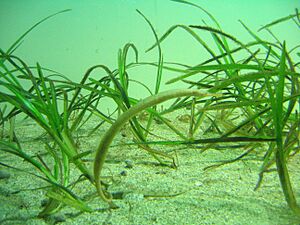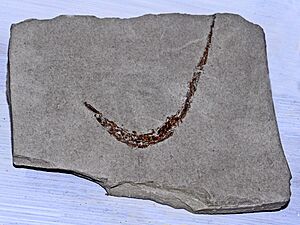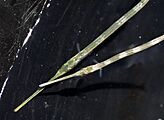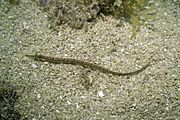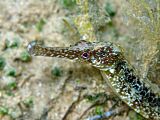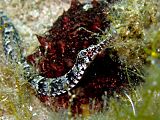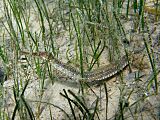Greater pipefish facts for kids
Quick facts for kids Greater pipefish |
|
|---|---|
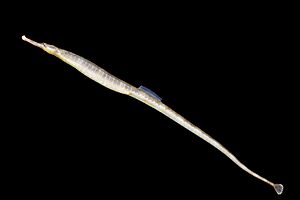 |
|
| Conservation status | |
| Scientific classification | |
| Synonyms | |
|
The greater pipefish (Syngnathus acus) is a cool fish that looks a bit like a long, thin stick! It belongs to the pipefish family, called Syngnathidae. This amazing creature lives in the ocean and is known for its unique body shape and how it cares for its young. It's a type of seawater fish.
Contents
What's in a Name?
The name Syngnathus comes from ancient Greek words. Syn means "grown together," and gnathos means "jaw." So, it's like "grown-together jaw." The second part of its name, acus, is Latin for "needle," which perfectly describes its long, thin body!
Appearance and Features
The greater pipefish has a long body that looks like it's made of many small segments, almost like armor. It can grow up to 45 centimeters (about 1.5 feet) long and feels quite stiff if you were to touch it. Its body is often square-shaped in cross-section.
These fish can be brown or green, with alternating lighter and darker stripes along their bodies. They have a long snout with their mouth at the very end. You might also notice a small hump on their back, just behind their eyes. Most greater pipefish are about 33 to 35 centimeters long, but some can reach up to 47 centimeters.
Male and Female Differences
The bodies of male and female greater pipefish are a bit different, especially when it comes to reproduction.
- Females: The top third of a female's belly can become quite deep, especially when she is full of eggs. This part can be twice as wide as the lower two-thirds of her body.
- Males: Male pipefish have special skin folds under their tail. These folds form a "brood pouch." When the male is carrying young, this pouch swells up. The young stay safe inside until they are ready to be released, usually when they are about 22 to 35 millimeters long.
Life Cycle and Reproduction
Greater pipefish are fascinating because the males are the ones who carry the eggs! This is a bit unusual in the animal kingdom. They usually reproduce about three times each year.
A female pipefish will lay her eggs into the male's brood pouch. A male's pouch can hold up to 400 eggs at once! The male then protects and carries these eggs until they hatch and the young fish are ready to swim on their own.
What They Eat
These fish are hunters! They love to eat small live creatures like mysids (tiny shrimp-like animals) and small prawns. They use their long snouts to suck up their prey.
Where They Live
The greater pipefish can be found in many places around the world. They are common around the British Isles and are also regularly seen in the Mediterranean Sea.
Their Home in the Ocean
These fish prefer to live in certain types of ocean environments. They are often found on southerly and westerly coasts. You'll typically spot them hiding among different types of seaweeds and seagrass beds. These plants provide great cover for them to hide from predators and ambush their prey.
Gallery



